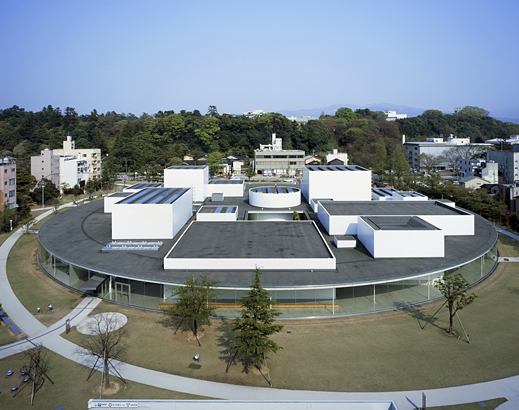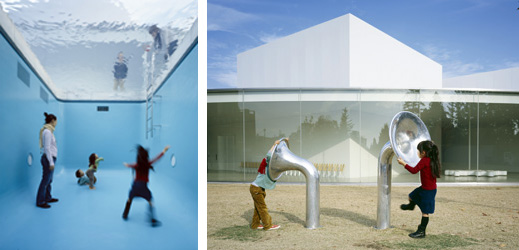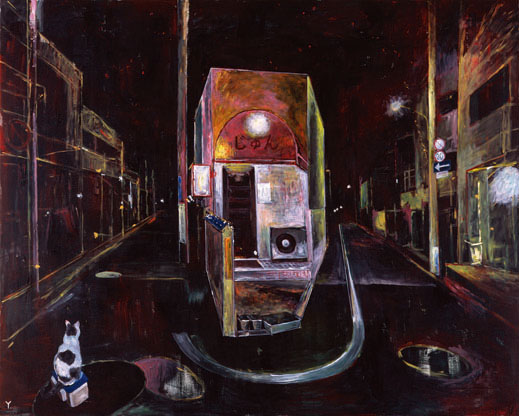 |
|
Here and There introduces art, artists, galleries and museums around Japan that non-Japanese readers and first-time visitors may find of particular interest. The writer claims no art expertise, just a subjective viewpoint acquired over many years' residence in Japan.
|
|
 |
|
|
 |
 |
Circles and Squares: Kanazawa's 21st Century Museum of Contemporary Art
Alan Gleason |
 |
 |
| Aerial view of the 21st Century Museum of Contemporary Art, Kanazawa |
Kanazawa is a proud old castle town. Often compared with Kyoto, it rivals the larger city in its wealth of beautifully preserved feudal-era buildings and gardens, as well as its overall cultural cachet. So it is fitting that Kanazawa recently built itself a world-class museum, yet somewhat curious that it chose to make this a museum of contemporary art -- and a very contemporary-looking one at that.
The 21st Century Museum of Contemporary Art, Kanazawa opened just five years ago on a broad plot of land right across the street from the city's most famous tourist attraction, the three-century-old Kenroku-en gardens. Approached from any angle, the building looks the same: it is a vast, white, glass-enclosed circle, surrounded by lawns speckled with a variety of sculptures. The one-story structure is anything but hermetic: it invites you to peer right inside, and you can enter from several points on the perimeter -- there is no "front entrance."
Once inside, however, it is a bit disappointing to find that the circular motif does not extend to the maze of galleries and hallways within. Most of the space is divided into squares and rectangles -- curiously, only one of the many galleries is circular like the building itself. Still, the light shining in through the glass outer wall, reflected by the luminous white interior and augmented by numerous courtyards, makes the museum a pleasant space to roam, and inevitably get lost, in.
Astonishingly, the museum, which is operated by Kanazawa City, only began acquiring its impressive collection in 2000 (planning began in 1996). The massive scale of the facilities has allowed for the incorporation of a number of large permanent installations into the design of the building. Among the most amusing and satisfying is Leandro Erlich's "The Swimming Pool" (2004), which looks like a deep, full-sized pool when viewed from the surface, but actually has only a few inches of water in it. Visitors entering the glass-ceilinged room below the pool appear to be strolling around underwater. Another work, James Turrell's "Blue Planet Sky" (2004), is an entire gallery with a big square hole cut into the roof, through which one can observe the change of light and movement of clouds in the sky while relaxing on the benches below.
When I visited the museum in late October I was lucky to be there in time to see its vast retrospective of the work of Tadanori Yokoo (b.1936), known worldwide for his psychedelic yet distinctively Japanese poster designs in the sixties. Sometimes unfairly compared to contemporaries like Peter Max, Yokoo always exhibited a more artistic, and bizarre, personal vision than a typical "poster artist," and in recent years he has devoted himself to increasingly abstract painting. At the Kanazawa exhibition, titled "Tadanori Yokoo Incomplete," which unfortunately closes on 3 November, his work from the last four decades covers several large gallery walls. It is an oeuvre that lurches wildly between cartoonish portraits of big-breasted women and dark abstractions hinting of chaos and death.
Yokoo's most intriguing recent works are found in two series that stand out in their consistency of motif, depth and resonance. One is a series of "Y-junction" paintings that depict a deserted intersection in an anonymous Japanese town, with a narrow, dilapidated building, a bar or restaurant of some sort, wedged between the two forks in the road. The time of day, weather conditions, and identifying markers like shop and street signs vary with each painting, but the cumulative effect is one of devastating bleakness and isolation. The original "Y-junction" was surely a neighborhood corner in Yokoo's hometown, and he seems to be revisiting a past that he knows can never be recaptured.
Even more recently, Yokoo has been experimenting with what he calls "public costume-play performance painting," in which he paints a huge canvas from scratch in front of an audience and records the entire process on video. One gallery is devoted to the fruits of this endeavor, all of them powerful -- and, the show's title notwithstanding, remarkably "complete." All are massive semi-abstractions dominated by the repeating motif of red concentric ripples in a body of water. Floating amid the scarlet ripples are distorted black figures that appear to be submerged human bodies. Videos (speeded up) of Yokoo creating these and other works can be viewed on nearby monitors.
Although the Yokoo show will close right about the time this article is being posted, a concurrent exhibition of large installation works selected from the museum's permanent collection will be on view until 11 April 2010. "Shift - Field of Fluctuation" devotes an entire gallery to each of nine contemporary artists from around the world, including Francis Alys, Gordon Matta-Clark, Anne Wilson, and Olafur Eliasson. (The museum's next major exhibition following Yokoo's will feature site-specific works by Eliasson from 21 November 2009 to 22 March 2010.)
On a visit to Kyoto last year I was bemused to find that the ancient capital had opened the world's biggest manga museum right in the middle of town, but it turned out to be the perfect tonic after a few days of relentless temple and garden viewing. In the same way, Kanazawa's 21st Century Museum adds a refreshing up-to-date edginess to the haughty old samurai bastion.
 |
left: Leandro Erlich, The Swimming Pool, 2004
Collection of the 21st Century Museum of Contemporary Art, Kanazawa
right: Florian Claar, Klangfeld Nr.3 für Alina, 2004
Collection of the 21st Century Museum of Contemporary Art, Kanazawa
|
 |
Tadanori Yokoo, Y Junction with a Cat, 2008
© Tadanori Yokoo
All images courtesy of the 21st Century Museum of Contemporary Art, Kanazawa.
Photos 1-3 by Atsushi Nakamichi / Nacása & Partners |
|
|
|
|
|
 |
|
 |
|
 |
21st Century Museum of Contemporary Art, Kanazawa |
 |
|
|
1-2-1 Hirosaka, Kanazawa City, Ishikawa Prefecture
Phone: 076-220-2800
Hours: 10:00 am - 6:00 pm (Until 8:00 pm on Fridays and Saturdays)
Closed Mondays and New Year's holidays (closed Tuesday when previous Monday is a national holiday)
Transportation: The museum is in Kanazawafs downtown Korinbo district, 10 minutes by bus from JR Kanazawa Station. By train, Kanazawa is 4 hours from Tokyo, 2 1/2 hours from Osaka. |
 |
|
|
 |
 |
Alan Gleason
Alan Gleason is a translator, editor and writer based in Tokyo, where he has lived for 25 years. In addition to writing about the Japanese art scene he has edited and translated works on Japanese theater (from kabuki to the avant-garde) and music (both traditional and contemporary). |
|
|
|
 |
 |
|